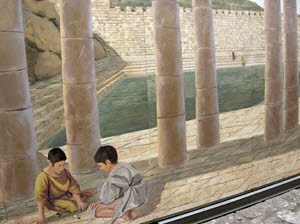What is the…
Pool of Siloam
Hebrew: בריכת השילוח
Meaning: sent or sending
also known as: Shiloah Pool

Here a notable miracle was done by our Lord in giving sight to the blind (John 9:7-11). It has been identified with the Birket Silwan in the lower Tyropoeon valley, to the southeast of the hill of Zion.
The water which flows into this pool intermittingly by a subterranean channel springs from the “Fountain of the Virgin”. The length of this channel, which has several windings, is 1,750 feet, though the direct distance is only 1,100 feet. The pool is 53 feet in length from north to south, 18 feet wide, and 19 deep. The water passes from it by a channel cut in the rock into the gardens below. (See EN-ROGEL.)
Many years ago (1880) a youth, while wading up the conduit by which the water enters the pool, accidentally discovered an inscription cut in the rock, on the eastern side, about 19 feet from the pool. This is the oldest existent Hebrew record of the kind. With great care it was deciphered by scholars, and has been found to be an account of the manner in which the tunnel was constructed.
Its whole length is said to be “1200 cubits;” and the inscription further notes that the workmen, like the excavators of the Mont Cenis Tunnel, excavated from both ends, meeting in the middle.
Some have argued that the inscription was cut in the time of Solomon; others—with more probability—refer it to the reign of King Hezekiah.
A more ancient tunnel was discovered in 1889 some 20 feet below the ground level. It is of smaller dimensions, but more direct in its course. It is to this tunnel that Isaiah (8:6) probably refers.
The Siloam inscription above referred to was surreptitiously cut from the wall of the tunnel in 1891 and broken into fragments. These were, however, recovered by the efforts of the British Consul at Jerusalem, and have been restored to their original place.
More information
- What is EN-ROGEL? Answer
- What is the CITY OF DAVID? Answer
- What is a POOL? Answer
- What is a SPRING? Answer
- WATER in the Bible
- MIRACLES of the Bible
- What is WASHING in the Bible? Answer